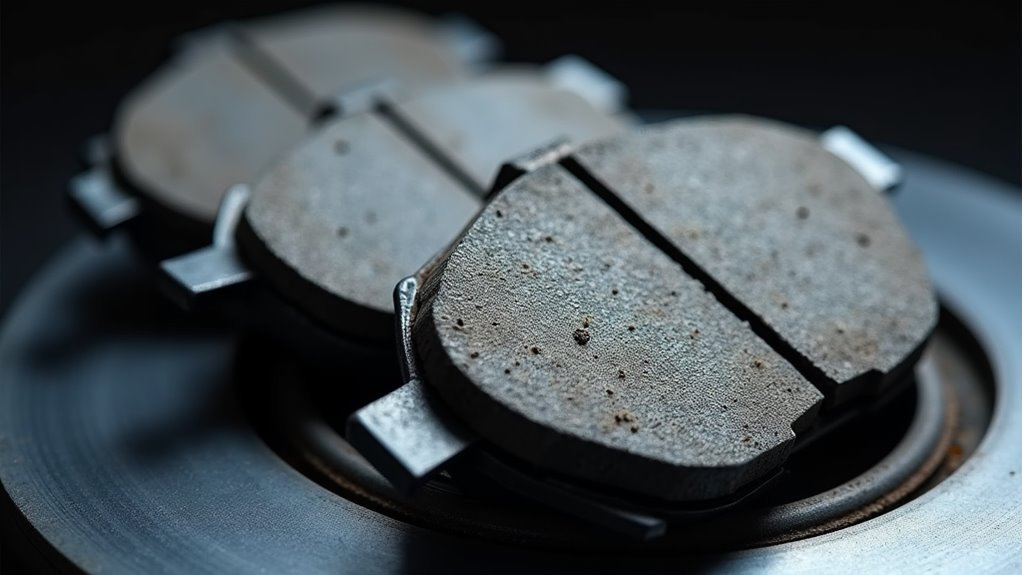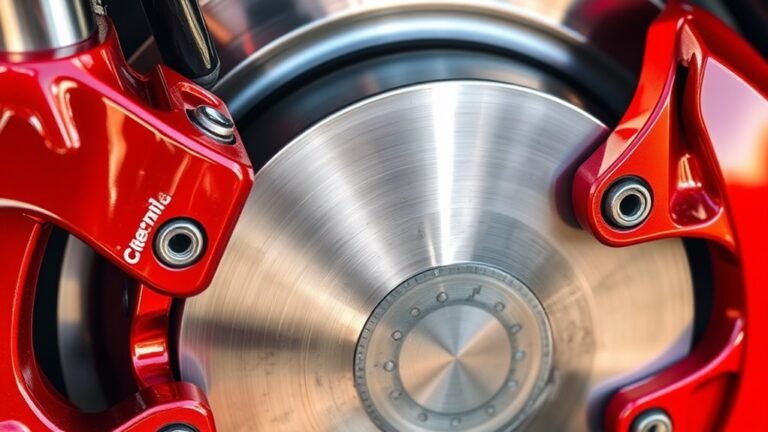If you’re noticing a squeak from your ceramic brake pads, it’s often due to moisture buildup on the pads creating screeching during braking. Rapid temperature changes can also disrupt their high-density composition, causing noise. Ceramic residue on rotors, rust formation, or misalignment of calipers and pads might trigger vibrations and sounds too. Proper break-in periods help, but stick around to uncover deeper insights into managing and minimizing these technical challenges with your braking system.
key Takeaways
- Humidity causes moisture buildup on ceramic brake pads, leading to screeching noises during braking.
- Rapid temperature changes can alter pad performance, resulting in operational squeaks.
- Ceramic residue deposits on rotors create friction, causing associated braking sounds.
- Rust formation on rotors increases friction, triggering squeaking in ceramic pads.
- Misalignment of calipers or pads causes vibrations, leading to noise during braking.
Understanding Ceramic Brake Pad Composition
The composition of ceramic brake pads is a meticulously engineered blend designed for ideal performance under demanding conditions.
As you analyze their makeup, you’ll notice a base of porcelain and clay, fortified with ceramic fibers like alumina or silicon carbide for heat resistance.
Fiber Integration plays a critical role, incorporating elements like Kevlar and mineral whiskers to enhance structural rigidity and durability under stress.
Moreover, Binder Properties are pivotal in holding this composite together.
Phenolic resin, a primary binder, guarantees cohesion while allowing flexibility through additives like nitrile rubber powder.
You’ll also find metallic filaments and graphite optimizing thermal conductivity.
This precise formulation results in high density, minimal rotor wear, and stable friction, tailored for demanding braking scenarios you encounter.
Additionally, the inclusion of copper fibers enhances durability in ceramic brake pads, contributing to their ability to withstand a broader range of temperatures and conditions.
Furthermore, ceramic brake pads are known for producing minimal brake dust, which helps maintain cleaner wheels and reduces the need for frequent cleaning.
It’s worth noting that their design ensures quiet operation during braking, making them a preferred choice for drivers seeking a smoother and less noisy experience.
Common Reasons for Squeaking in Ceramic Pads
Many factors can trigger squeaking in ceramic brake pads, and understanding them is key to addressing the issue.
You’ll notice that environmental conditions like Humidity Impact play a significant role, as moisture accumulation on pads causes screeching.
You’ll find that humidity can greatly affect ceramic brake pads, with moisture buildup often leading to noticeable screeching during braking.
Similarly, Temperature Effects from rapid changes can alter brake performance, leading to noise during operation.
Beyond environment, mechanical issues also contribute to squeaks. Additionally, the type of brake pad material can influence noise levels, as certain materials squeak more due to their composition. Regular inspection of your brakes can help identify issues early, especially if you hear squealing or screeching noises indicating potential wear. A common issue with new ceramic pads is the need for a proper break-in period to ensure they mate correctly with the rotors through controlled bedding processes.
Here are common reasons you might hear squeaking:
- Moisture Buildup: High humidity leads to wet pads, causing hissing sounds.
- Rotor Deposits: Ceramic residue on rotors creates friction and noise.
- Rust Formation: Corrosion on rotors increases friction, triggering squeaks.
- Misalignment: Uneven caliper or pad alignment causes vibration and sound.
Analyze these factors to pinpoint why your ceramic pads squeak.
Performance Benefits and Noise Challenges
Explore how ceramic brake pads balance impressive performance gains with occasional noise hurdles.
You’ll notice their superior Durability Impact, lasting up to 23% longer than semi-metallic pads in stop-and-go traffic, while resisting heat and corrosion effectively.
They excel in typical driving, offering stable braking across dynamic temperatures with minimal dust. This makes them ideal for drivers seeking low dust output in their braking systems.
Additionally, ceramic pads produce significantly less noise due to their uniform structure, which helps in minimizing vibrations.
However, you might encounter Environmental Noise challenges under specific conditions.
Though generally quieter than metallic pads, ceramic pads can emit high-frequency sounds, sometimes audible depending on wear or driving scenarios.
Their operational frequency often stays beyond human hearing, yet it’s a factor to keep in mind.
For instance, brands like Akebono offer quiet operation with their ceramic pads, making them a popular choice for daily drivers.
With proper maintenance, you can optimize their lifespan and performance, ensuring these pads deliver reliability while managing the occasional noise trade-off in your daily commute.
Effective Solutions to Reduce Brake Noise
How can you tackle the occasional squeak from ceramic brake pads without compromising their performance?
You’ve got several precise strategies to minimize noise while maintaining braking efficiency.
Discover effective strategies to reduce brake noise while preserving top-notch braking performance with ease.
By focusing on technical solutions, you can address vibrations often amplified by factors like Suspension Adjustments or improper Tire Selection.
Here are key actions to take:
- Ensure Proper Installation: Align and secure pads to reduce vibrations.
- Bed Your Brake Pads: Apply gentle pressure initially to conform pads to rotors.
- Maintain Regularly: Clean and inspect components to prevent debris buildup.
- Use Quality Lubrication: Apply appropriate lubricants to caliper slides for smoother, quieter operation.
Additionally, consider the design of the brake pads, as some feature advanced technology to further dampen noise quieter operation design. For instance, certain brands like Carquest use patented HEX shim technology to significantly reduce brake noise.
Following the bedding process, allow the brakes to cool completely to ensure optimal friction performance and prevent uneven wear.
With these steps, you’ll mitigate noise effectively, ensuring your system—factoring in Suspension Adjustments and Tire Selection—performs effectively without annoying squeals.
Comparing Ceramic Pads With Other Materials
While ceramic brake pads stand out for their durability and low noise, it’s essential to compare them against other materials to understand their unique advantages and limitations.
You’ll notice ceramic pads outlast semi-metallic and organic pads, with less dust production.
However, Cost Differences are notable—ceramic pads are pricier than semi-metallic and organic options, though less expensive than carbon-ceramic pads.
Analyzing Weight Variations, you’ll find carbon-ceramic pads are substantially lighter than traditional metal or standard ceramic pads, enhancing vehicle performance.
Semi-metallic pads offer a stronger initial bite in cold conditions, unlike ceramic, but they’re noisier.
Organic pads fall between in noise levels but lack durability.
Additionally, ceramic pads are known for providing smoother braking experience compared to other materials, ensuring confident control during daily driving.
Moreover, ceramic pads may underperform in extreme cold conditions, which can affect braking efficiency in certain climates.
It’s also worth noting that ceramic pads are ideal for quiet highway driving, making them a preferred choice for commuters seeking minimal noise and dust.
Maintenance Tips for Quiet Braking
Explore into maintaining quiet braking with ceramic pads by prioritizing routine care and precise techniques. You’ve gotta establish routine habits to inspect pads for wear, contamination, and uneven surfaces. Replace them promptly if they’re beyond limits. Weather influence can’t be ignored—moisture and temperature shifts may cause squeaks, so monitor conditions closely. Clean components with brake cleaner to remove dust and glaze, and apply high-temperature lubricants to contact points to curb vibrations. Additionally, proper bedding of new pads ensures a uniform friction layer on the rotor, helping to prevent glazing issues. For enhanced performance, consider brands like Detroit Axle, known for their superior stopping performance in ceramic brake pads. For a reliable option, explore Bosch brake pads, which offer low dust operation and quiet performance with their QuietCast models.
Here’s how to achieve silence:
- Inspect rotors for scoring or glazing.
- Resurface rotors before installing new pads.
- Use anti-squeal shims or coatings.
- Avoid excessive braking to prevent heat buildup.
Stick to these steps, and you’ll minimize noise while optimizing ceramic pad performance.




